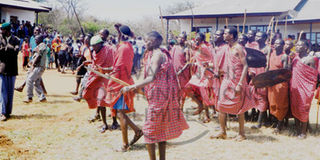TRAVEL : More fun and rich culture at the Haydom festival

People in hundreds attended to witness the traditional dances from across the four corners and far, paired with some of the awe-inspiring creativity and thought-provoking talents. PHOTO | ELISHA MAYALLAH
What you need to know:
The reason for this preoccupation was the 4CCP Cultural Festival, this time, in its fourth edition.
Heritage to reflect and connect with history and culture celebrations had occupied a large part of the crowd this past week at Haydom. And I was totally disconnected from the city-life.
The reason for this preoccupation was the 4CCP Cultural Festival, this time, in its fourth edition. For years’ down the line the extraordinary festivals have celebrated the culture coexistence of four popular African tribal languages of the Bantu, Khoisan, Nilo-Saharan and the Afro-Asiatic, bringing performances to the local community and culminating into a competition.
Haydom is located nearly 120 kms from Babati, the administrative capital of Manyara region. Every year it hosts a cultural festival that takes the crowd into a journey of the local lifestyle, back-to-back, to honour the ancient history of the four popular African languages.
It would not be an understatement to confirm that I was enthralled by different artists heavily oriented towards the theme of this year; festival - culture for the development of the communities well being. This was being celebrated through the universal platform of open-air dancing sessions and traditional sports such as archery and stick fighting.
The 4CCP cultural centre, which runs the festival uses arts and live performances to validate the lives of the Wanyiramba and Wanyisanzu from Singida region (the Bantu family); Hadzabe (Khoisan family); Nilotic Datoga (Nilo-Saharan family) and the Cushitic Iraqw (Afro-Asiatic family).
The focus of the festival, according to Mr Nelson Faustin, the manager for the cultural event is to promote peace and harmony by assembling renowned local traditional dance groups.
Ms Eliminata Awet the coordinator of the 4CCP cultural centre at Haydom worked with other stakeholders such as the Haydom Lutheran Hospital, Norwegian Church Aid, Women Legal Aid and Tanzania Tourist Board to stage the three-day event, from November 12 to 14, 2015.
The neighbourhood known for its warm hospitality and home to a host of fascinating people, many of whom swarmed the main hall in hundreds came from Mbulu, Babati and Katesh (in Manyara region; Isanzu from Singida region and beyond. They all came to listen to the alien and the familiar sounds of exotic instruments.
The amazing weekend had the mainstream and established artists on-stage throughout the three days from the Four Corners (4CCP) in which the Mazangiri and Waisene from Singida region; Datooga from Getanyamba, Mulbadaw and Ngorongoro; Hadzabe from Kipamba and the locals Iraqw.
Other invited traditional troops were from Mwanza (Mchelemchele Sukuma dance); Ngorongoro (Maasai dance) and from Dodoma, the Wagogo (Sangarasasi).
People in hundreds attended to witness the traditional dances from across the four corners and far, paired with some of the awe-inspiring creativity and thought-provoking talents that created long-lasting memories.
Each day of the festival was a feast of senses, body and soul. Considering the sheer size and diversity of the gathering, the atmosphere was placid, rustic and congenial.
Dressed in black, shaking legs apart, the Wagogo (Sangarasasi) and Wasukuma (Mchelemchele) gave revellers grand performances. The Wagogo impressed many as they jostled for prime locations of the main hall as they hang drums between the grip of the legs of women artists and clamoured the instrument to the tribal rhythms of the Wagogo. Drums are a big part of the African percussion culture so it was no surprise that they featured strongly in the presentation. When drums didn’t provide the rhythmic backing, it came from a kayamba – a reed-covered board filled with seeds or stones that could be rattled or struck for variation.
By far my favourite show of the festival was the Wagogo with their romantic sounds and exotic local instruments such as Kayamba. When Elirehema Maturo from the Tanzania Tourist Board (TTB) shared his liking to the Mchelemchele group I was not amused either.
As it turned out later, the Wasukuma won the overall category with the Wagogo coming second, while Mazangiri and Kinita Isene groups were the best in the Bantu category. The Iraqw and Datoga Getanyamba scooped second slots leaving the Datoga Mulbadaw, Hadzabe Kipamba, Datoga Ngorongoro and the Maasai were the third winners.
E-mail: [email protected]




